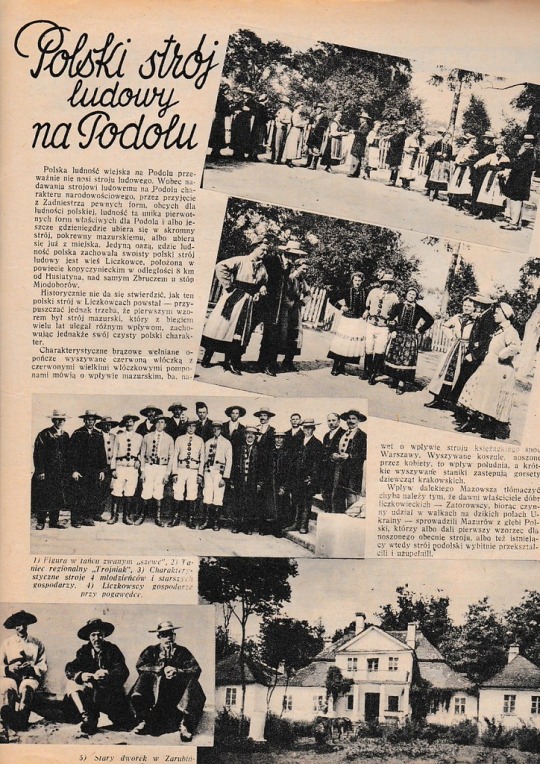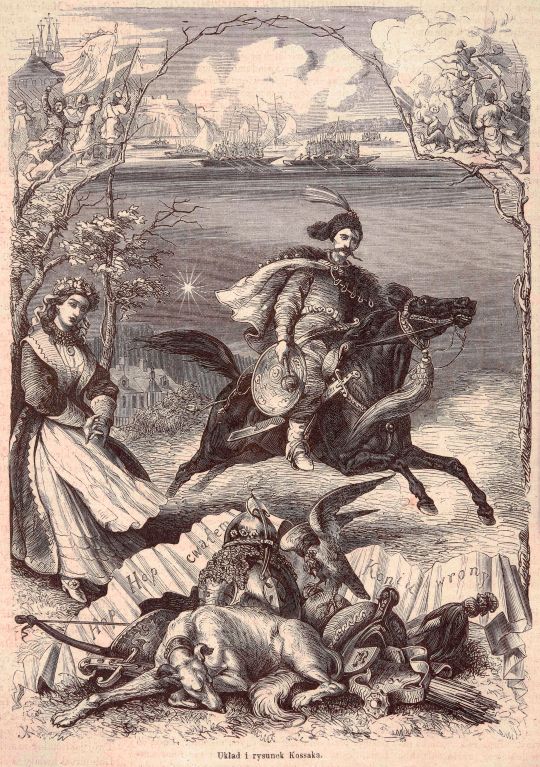#Tygodnik
Explore tagged Tumblr posts
Text
O CO WALCZY >>WALKA MŁODYCH<
“Solidarność Jastrzębie” Tygodnik Zarządu Regionu Śląsko-Dąbrowskiego NSZZ “Solidarność” Nr 16. Katowice, 25 sierpnia 1981:3 vk.com/album467751157_281380223 Narkomania i narkotyki, a ściślej mówiąc – problem zażywania przez młodzież środków o działaniu odurzającym i halucynogennym jest w Polsce stosunkowo nowy. Do niedawna oficjalne statystyki określały liczbę narkomanów w naszym kraju na…

View On WordPress
0 notes
Text
Mój nieżyjący już i nieodżałowany mentor Stefan Figlarowicz mawiał
„Proszę państwa, proszę sobie zapamiętać, że to co w uszach to i w głowie, jak będziecie słuchać muzyki łatwej i przyjemnej, to w głowie wam szanowni państwo pozostanie tylko łup, bum, łup i bum. Dlatego polecam, słuchajcie Dwójki Polskiego Radia. To samo jest z oczami, dlatego polecam wam, czytajcie Tygodnik Powszechny”.
Przyznam, że miał rację, ja osobiście rozszerzam spektrum poznania o kanał Mezzo, wizyty osobiście w Operze i Filharmonii. Jeżeli chodzi o oczy, to rozszerzyłem spektrum o magazyny Topos i Literaturę na świecie.

0 notes
Text
"Jolanta Kwaśniewska – pamiętamy, kiedy kończyła się kadencja jej męża, spekulowano, że gdyby chciała wystartować w wyborach prezydenckich, wygraną miałaby w kieszeni. Nie wystartowała – i dobrze, gdyż w dużym stopniu wstrzymałoby to rozwój polskiej demokracji. Zamiast niej budowalibyśmy bowiem dynastię. Ale sentyment do Kwaśniewskiej jest żywy. To wzór kobiety, która na tamte czasy, można powiedzieć, była progresywna. (...) Sytuuje się gdzieś w centrum, ale miałaby realne szanse namieszać."
prof. Przemysław Sadura
0 notes
Text








Zagłoba & Bohun endlessly portrayed together...
Juliusz Kossak (1824-1899), watercolour, 1884, 42 cm X 33 cm
Anonymous, oil on canvas, late 19th century/beginning of the 20th century, 40 cm X 32 cm
Anonymous, oil on canvas, after 1884, 27 cm X 22 cm
Andrzej Zajkowski (1851-1914), woodcut (prepared as an illustration for the newspaper "Tygodnik Illustrowany"), 24.04.1886.
Anonymous, gouache, 1895, 28,5 cm X 22 cm
Kajetan Kosiński (1847-1335), watercolour, late 19th century/beginning of the 20th century, 46,5 cm X 36,5 cm
Anonymous, oil on canvas, late 19th century, 69 cm X 43 cm
Polish postcard from the late 19th century/beginning of the 20th century
#art#polish art#ukrainian art#jurko bohun#ivan bohun#jan onufry zagłoba#ogniem i mieczem#with fire and sword#trylogia#trylogia sienkiewicza#cossack art#cossack heroes#polish literature#trylogiart#trylogia art#trylogia sensem życia
32 notes
·
View notes
Note
All I can say is: Mind positively blown!! You are getting an honorary degree in Witcher studies for this, right? RIGHT???
oh man! thank you!! honestlyyyy i wish i could get a real degree in witcher studies—or, well, i mean pursue this kind of research as a focus of an academic study. i mean, i would like to go to grad school one day… well, it’s a little dream ok 😂
all the people who wrote the journal articles and essays i’ve looked at, who created all the literature looking into polish speculative fiction (and ofc specifically the witcher), are like role models to me, even though i had to read most of their work through google translate and DeepL 😭
Zbigniew Wałaszewski, “Wiedźmin: pierwszy polski supersystem rozrywkowy” in Obraz literatury w komunikacji społecznej po roku ‘89
EVERYONE involved in Wiedźmin: polski fenomen popkultury (Wrocław University) but especially Paulina Drewniak’s “Are we there yet?” and Anna Wróblewska’s “Jak napisać bestseller?”
Adam Flamma, (who was also published in the previous, but moreso for) Wiedźmin: historia fenomenu, which is just so comprehensive as a resource it’s hard to not cite in everything
Anna Michalska’s thesis, Otherness and Intertextuality in The Witcher (Utrecht University)
and some magazine articles (that are more essay- than article-like):
Dominika Materska and Ewa Popiołek, “Trzy gra Sapkowskiego” (Nowa Fantastyka, (143) 1994)
Agnieszka Fulińska, “Basń, która ocala” (Tygodnik Powszechny, (29) 1999)
agnieszka fulińska is also kind of a freaking legend because she did the first ever known translation of “the witcher” (hers was “the hexer”) short story into english—as part of a project between ŚKF and superNOWA in 2000 to translate polish authors into english… also tomasz bagiński (yes, the same tomasz as the one we know from platige image and netflix) did the cover and illustrations for this).
also, these aren’t “witcher”, specifically, but related topics:
Stanisław Krawczyk’s “Popular Authors in Search of Recognition” (Adam Mickiewicz University, Poznań)
Piotr Siuda, “In Pursuit of Pop Culture” (Kazimierz Wielki University, Bydgoszcz)
so like… it is something people do professionally, academically, so it’s a dream that is perhaps one day possible…
however, there are two necessary precursor accomplishments that need to happen before anything happens on this front:
>learn polish
>become financially stable
… each one is as hard as the other 😂
#also dont laugh but ive looked and theres no in-person polish classes around me 🤐 i could do virtual but considering i’d have to pay money#ask#anon
8 notes
·
View notes
Text
Премьер-министр Польши Дональд Туск отрекся от своего прежнего высказывания о Трампе, в котором он обвинял политика в сотрудничестве с российскими спецслужбами, об этом сообщает интернет-портал WPolityce.
По его данным, в четверг на пресс-конференции главы правительства Польши журналистка издания Tygodnik Solidarność Моника Рютке напомнила Туску его прежние утверждения о «зависимости Трампа от российских спецслужб» и о том, что Трамп, возможно, «был завербован россиянами». В ответ Дональд Туск заявил, что он «такого предположения никогда не делал».
Как сообщила позже Моника Рютке, после пресс-конференции с ней связались представители канцелярии Дональда Туска и известили ее о том, что прекращают с ней всякое сотрудничество.
3 notes
·
View notes
Text

Article from Tygodnik Antena about Polish folk costumes from the village of Liczkowce/Lychkivtsi in the region of Podillia, 1938
13 notes
·
View notes
Text
Anyway since I've been ruminating about the tendency to conflate EE Jewish history writ large w/ "heritage" (in my less generous moments I call it "the genealogy impulse") & grousing about the way "deassimilation" is used re: political work and language learning, and feeling itchy about the stories some recently-radicalized American Jews I've encountered (often raised middle-class, liberal, Zionist, though by no means always) tell themselves about, well, Eastern European Jews, situated historically. I am making a reading list in descending order of Esoteric:
--Assimilated Jews in the Warsaw Ghetto, 1940-1943 by Katarzyna Person --From Rochel to Rose & Mendel to Max by JH Greenberg --Jewish Immigrants and American Capitalism, 1880-1920 by Eli Lederhandler --A Rosenberg by Any Other Name by Kirsten Fermaglich --The chapter of Irena Krzywicka's memoir where she explains her rationale for joining PPS instead of the Bund (okay, it's not in English, I'll translate it) --Naftali Vaynig's Yiddish-language review of Stefania Zahorska and Herminia Naglerowa in Literarishe bleter, 1938 --Julian Tuwim's Polish interview translated into Yiddish for Literarishe bleter, the famously but cryptically antisemitic review of Leśmian in Tygodnik illustrowany, the excerpt of Stefania's Korzenie published in Wiadomości, Słowacki's "Hymn," Melech Ravich's last attempt at Polish-language poetry, & Sutzkever's "Tsu poylin"
14 notes
·
View notes
Text

Ludwik Stasiak (1858-1924)
Alegoria szatana (Pan świata)
olej na płótnie, 200 x 145 cm, ok. 1900, Muzeum Narodowe w Krakowie.
他是波蘭畫家,漫畫家,記��,藝術史學家和出版商。他的作品種類繁多,並為Bluszcz,Kłosy和Tygodnik Illustrowany等雜誌提供插圖。他還是一些流行的歷史小說的作者。
He was a Polish painter, cartoonist, journalist, art historian and publisher. He worked in a wide variety of genres and provided illustrations for magazines such as Bluszcz (czasopismo)/(Ivy), Kłosy (czasopismo) /(Ears) and Tygodnik Illustrowany. He was also the author of some popular historical novels.
5 notes
·
View notes
Text
María Hiszpańska-Neumann (1917-1980) pintora y artista gráfica polaca.

Nació en Varsovia en la familia de Stanisław Feliks Hiszpański , un famoso zapatero, y Zofia Janina, de soltera Cracovia. Ella era la hija menor; tenía dos hermanos mayores: Zdzisław y Stanisław, quienes también se convirtieron en artistas.

Se graduó en la escuela secundaria Popielewska-Roszkowska en 1935 y luego comenzó a estudiar en la Academia de Bellas Artes de Varsovia. Se graduó en 1939, pero no logró completar su diploma antes de que estallara la guerra.
El padre de María murió durante un bombardeo en 1939. Durante la ocupación alemana participó activamente en la Unión de Lucha Armada.

Durante la ocupación fue miembro de la Unión de Lucha Armada y fue responsable de la distribución de la prensa ilegal. Por esta actividad clandestina fue arrestada el 19 de junio de 1941 junto con la familia del profesor Józef Jan Siemieński y encarcelada en Radom y luego en Pińczów.

El 10 de abril de 1942 fue deportada al campo de Ravensbrück, donde recibió el número 10219.
Durante su estancia en el campo realizó numerosos dibujos. María dibujó en secreto las escenas de los guardias que representan la vida en el campo. Trató esta ocupación como su deber, una especie de misión, obligándose a mostrar las realidades del infierno de los campos.
Fue obligada a trabajar en la fábrica de armas de Nuevo Brandeburgo, en abril de 1945 escapó durante la evacuación y vivió hasta ver la liberación en el bosque.

En el verano de 1945 regresó a Varsovia. Se ocupó principalmente de la gráfica de libros. Creó numerosos grabados en madera, principalmente en la técnica de borde a borde. Colaboró con la editorial "Wiedza", luego "Książka i Wiedza".

En la década de 1950 colaboró con Tygodnik Powszechny. Creó numerosos dibujos dedicados a la vida en los campos de concentración, algunos de los cuales formaron parte de la colección del museo de Ravensbrück.
En los años 1954-1955 viajó a Bulgaria. A partir de los bocetos realizados allí se creó el álbum de xilografías "Tyrnovo".

En 1960 permaneció en Egipto durante varios meses con motivo de su exposición individual . Dado que en la década de 1960 no había ningún interés en cooperar con María de las editoriales polacas, decidió cooperar con editoriales de la RDA . La edición de " Tristan und Isolde " de Gottfried von Strassburg en alemán con ilustraciones en español fue reconocida en 1961 como el libro más bello del año.
A partir de 1965 empezó a pintar paredes, especialmente en edificios religiosos. Colaboró con el arquitecto Władysław Pieńkowski .

Firmaba sus obras con el dibujo de un ratón; el símbolo proviene de su apodo "Ratón".
Murió en Varsovia, enterrada en el cementerio de Służewo en ul. Wałbrzyska .

Le ponemos cara.

0 notes
Text
Mój nieżyjący już i nieodżałowany mentor Stefan Figlarowicz mawiał
„Proszę państwa, proszę sobie zapamiętać, że to co w uszach to i w głowie, jak będziecie słuchać muzyki łatwej i przyjemnej, to w głowie wam szanowni państwo pozostanie tylko łup, bum, łup i bum. Dlatego polecam, słuchajcie Dwójki Polskiego Radia. To samo jest z oczami, dlatego polecam wam, czytajcie Tygodnik Powszechny”.
Przyznam, że miał rację, ja osobiście rozszerzam spektrum poznania o kanał Mezzo, wizyty osobiście w Operze i Filharmonii. Jeżeli chodzi o oczy, to rozszerzyłem spektrum o magazyny Topos i Literaturę na świecie.

0 notes
Text
"Po zamachu smoleńskim i niemieckich wpływach PiS tworzy nowe MONSTRUM, które zagraża naszemu narodowi. To inwazja imigrantów. Będą molestować polskie niewiasty. Pisowscy propagandyści filmują na ulicach ludzi o innej karnacji i wołają, że to polityka Tuska i jego bandy."
Tomasz Jastrun
0 notes
Text

Uczestniczki Zjazdu Kobiet w sali Towarzystwa Higienicznego w Warszawie, 1917, „Tygodnik Ilustrowany”, 15 IX 1917, nr 37, Biblioteka Uniwersytetu Łódzkiego, licencja PD, źródło: Biblioteka Cyfrowa UŁ (źródło)
@abwwia
0 notes
Text

Juliusz Kossak (1824-1899)
Hop, hop, cwałem koniu wrony, Leć do półków, do méj żony,
Gallop, gallop my black horse, Go to regiments, to my wife...
Illustration to the romantic poem "Dumka" by Józef Bohdan Zaleski (1802-1886), born in Bohatyrka (near Kyiv), writing poetry in Polish and representing the so-called "Polish Romantic Ukrainian school" - a group of the early 19th century artists, fascinated with Ukrainian history, culture, music, folklore and, of course, the Cossack theme.
Illustration has been published in the Polish weekly newspaper "Tygodnik Ilustrowany", 121, 23.04.1870. Available here:
#art#polish art#polish literature#polish vintage press#vintage press illustration#cossack art#cossack heroes#cossacks#ukrainian heritage#ukrainian culture#ukrainian history#horse art#juliusz kossak#romantic literature#polish romanticism
54 notes
·
View notes
Text

Wisława Szymborska Jacyś ludzie cyt. za: Tygodnik Powszechny
1 note
·
View note